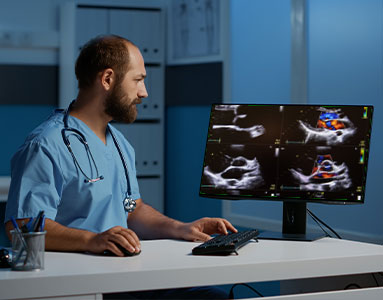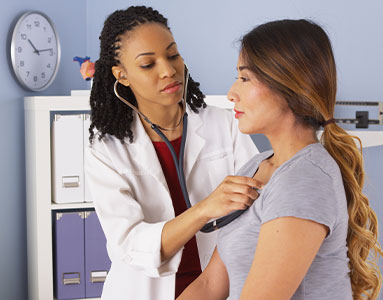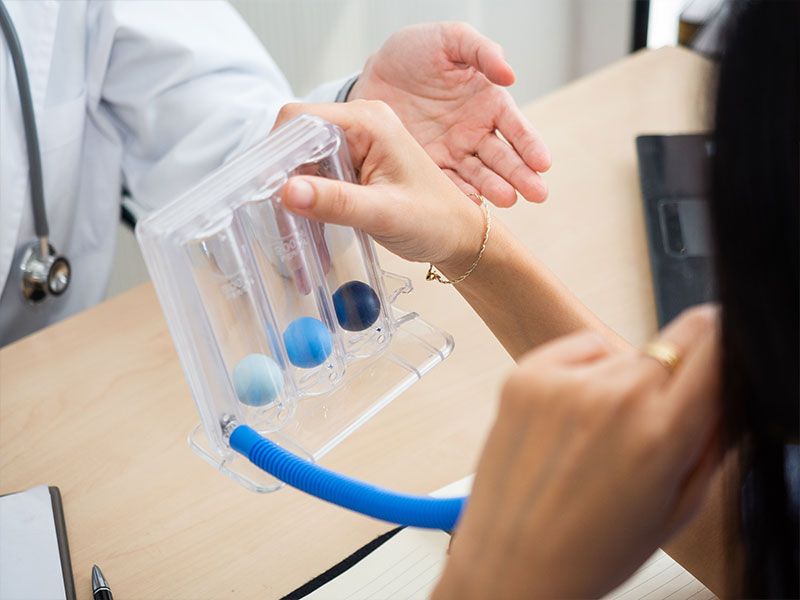Cardiopulmonary Science, B.S.
Cardiopulmonary Science (CPS), also known as respiratory therapy, is an allied health
profession that provides for the diagnosis, treatment, management, preventive care,
and rehabilitation of patients with cardiopulmonary abnormalities. Florida A&M University
changed the program name from respiratory therapy to cardiopulmonary science in 1998.
Patients who have asthma, chronic bronchitis, emphysema, cystic fibrosis, and coronary
heart disease are commonly evaluated and treated by respiratory therapists. Respiratory
therapists work with patients in the critical care unit, emergency room, newborn nursery,
outpatient clinic and critical care transport.
Working with physicians and other health professionals, respiratory therapists assess
the health status of clients, manage complex diagnostic and life support systems,
operate and maintain sophisticated monitoring devices, and routinely administer medications,
as well as perform other procedures.
Program Goals:
To prepare graduates with demonstrated competence in the cognitive (knowledge), psychomotor(skills), and affective (behavior) learning domains of respiratory care practice as performed by registered respiratory therapists (RRTs).
To prepare leaders for the field of respiratory care by including curricular content with objectives related to the acquisition of skills in one or more of the following: management, education, research, and advanced clinical practice (which may include an area of clinical specialization).
Faculty | ACADEMIC COURSE CURRICULUM
CARDIOPULMONARY SCIENCE APPLICATION
Learning Compact | Accreditation

What is respiratory therapy?
Respiratory Therapy is a specialized healthcare field where practitioners are trained
in pulmonary medicine in order to work therapeutically with people suffering from
pulmonary disease.
A day in the life of an RT might include:
- Diagnosing lung and breathing disorders and recommending treatment methods.
- Interviewing patients and doing chest physical exams to determine what kind of therapy is best for their condition.
- Consulting with physicians to recommend a change in therapy, based on your evaluation of the patient.
- Diagnosing lung and breathing disorders and recommending treatment methods.
- Interviewing patients and doing chest physical exams to determine what kind of therapy is best for their condition.
- Consulting with physicians to recommend a change in therapy, based on your evaluation of the patient.
- Analyzing breath, tissue, and blood specimens to determine levels of oxygen and other gases.
- Managing ventilators and artificial airway devices for patients who can’t breathe normally on their own.
- Responding to Code Blue or other urgent calls for care.
- Educating patients and families about lung disease so they can maximize their recovery.

Respiratory Therapist Careers
Where RTs Work- IN HOSPITALS, giving breathing treatments to people with asthma and other respiratory conditions.
- IN INTENSIVE CARE UNITS managing ventilators for critically ill patients
- IN EMERGENCY ROOMS delivering life-saving treatments.
- IN NEWBORN AND PEDIATRIC UNITS, helping children with conditions ranging from premature birth to cystic fibrosis.
- IN OPERATING ROOMS, working with anesthesiologists to monitor patients’ breathing during surgery.
- IN PATIENT’S HOMES, providing regular check-ups and ensuring people have what they need to stay out of the hospital.
- IN SLEEP LABORATORIES helping to diagnose disorders like sleep apnea.
- IN SKILLED NURSING FACILITIES and pulmonary rehabilitation programs, helping older people breathe easier and get more out of life.
- IN DOCTOR’S OFFICES, conducting pulmonary function tests and providing patient education.
- IN ASTHMA EDUCATION PROGRAMS, helping children and adults learn how to cope with the condition.
- IN SMOKING CESSATION PROGRAMS, assisting those who want to kick the habit for good.
- IN AIR TRANSPORT AND AMBULANCE PROGRAMS rushing to rescue people needing immediate medical attention.
- IN CASE MANAGEMENT PROGRAMS helping devise long-term care plans for patients.

Respiratory Therapist Salary Expectations
GROWING FAST
According to the U.S. Bureau of Labor Statistics, the “Employment of respiratory therapists
is projected to grow 13 percent from 2022 to 2032, much faster than average for all
occupations.” This is explained by the fact that as the U.S. population ages, so too
will an increased incidence of respiratory conditions, thus leading to an increased
demand for respiratory therapy services. Median pay for RTs is about $70,500/year.
The states with the highest employment rates for respiratory therapists are:
- California
- Texas
- Florida
- New York
- Ohio

Respiratory Therapist Frequently Asked Questions (FAQs)
Q: What is an RT’s work schedule like?
A: Most respiratory therapists work full-time. They typically work in medical facilities
that are always open, such as hospitals; they may have shifts that include nights,
weekends, or holidays.
Q: What other jobs can I acquire with an RT degree?
A: Respiratory therapists who seek out leadership roles find great career ladders in
most settings. RTs who excel on the job often advance from staff therapist to shift
supervisor to department manager. Some therapists have ascended to the highest levels
of hospital administration.
RTs specializing in home care often branch out even further, establishing their own
respiratory home care companies to provide equipment and clinical services. Others
have started successful businesses providing respiratory diagnostics services, patient
care education, and other related services. Some therapists also venture into the
corporate world, taking positions with equipment manufacturers as product or marketing
specialists. With the knowledge gained through years of experience as an RT, their
technical and patient care know-how is considered invaluable to these firms.
If you have a passion for education, you can parlay a successful career as an RT into
a faculty position at a respiratory therapy school or as a clinical education coordinator
for a hospital or other respiratory therapy department. These therapists also get
involved in respiratory care research, conducting the clinical studies that form the
scientific basis for the progression.
Q: What is the work environment like for respiratory therapists?
A: Most respiratory therapists work in hospitals, but some practice in skilled nursing
facilities and physicians’ offices. Other work environments include home health agencies,
respiratory therapy clinics, rehabilitation centers, and diagnostics labs. Within
hospitals, respiratory therapists work in various areas, including emergency departments,
neonatal intensive care units, and critical care units.
More about Cardiopulmonary Science
The curriculum in the CPS is designed to prepare advanced respiratory care practitioners.
- Before applying to the program, candidates must first be admitted to the university.
- The curriculum is divided into two phases: a pre-professional curriculum and a professional curriculum.
- To apply for admission into the professional curriculum, a grade of "C" or better is required in all pre-requisite courses.
- Students must complete a Cardiopulmonary Science Program application to be considered and accepted for admission into the professional curriculum.
- Only one class is admitted annually (fall semester).
- The program begins accepting applications in the spring semester.
- The professional phase consists of classroom, laboratory, and clinical experiences.
- Students must clear a criminal background check annually to be eligible to participate in courses involving patient/client contact and/or medical record information.
- Students must complete 16 hours (clock) of clinical observation of respiratory therapists at an approved clinical site as determined by a CPS program representative.
- The curriculum is structured to provide the necessary knowledge and clinical competence requisite to entry-level practice and eligibility to advanced practitioner credentials.
- All courses in the professional phase must be completed with a "C" grade or better. In addition, students must obtain passing scores for comprehensive exit examinations.
Professional Credentials
A Bachelor of Science degree is awarded upon completion of the curriculum and comprehensive examinations. Graduates are eligible to apply for the National Board for Respiratory Care entry-level examination administered by the National Board for Respiratory Care (NBRC). Successful candidates will be eligible to apply for the Advanced Practitioner Examinations administered by the NBRC.
The CPS Program is accredited by the Commission on Accreditation for Respiratory Care (CoARC) #200321. Through October, 2034.
Commission on Accreditation for Respiratory Care (CoARC)
264 Precision Boulevard, Telford, TN 37690 USA
Phone: (817) 283-2835
www.coarc.com
The Cardiopulmonary Science Program (CoARC Program #200321), offering the Bachelor of Science degree, is located at Florida A&M University, School of Allied Health Sciences, 1601 S. Martin Luther King Jr. Blvd, Tallahassee, FL 32307. This program is accredited by the Commission on Accreditation for Respiratory Care (CoARC) (www.coarc.com).
CoARC’s Programmatic Outcomes Webpage
CoARC accredits respiratory therapy education programs in the United States. To achieve
this end, it utilizes an ‘outcomes based’ process. Programmatic outcomes are performance
indicators that reflect the extent to which the educational goals of the program are
achieved and by which program effectiveness is documented.
Program Faculty
| Name | Phone | |
|---|---|---|
| Ms. Kandy Woods Program Director |
kandy.woods@famu.edu | (850) 412-7863 |
| Mr. James Wright Director of Clinical Education |
james2.wright@famu.edu | (850) 412-7863 |
| Dr. David Saint Medical Director |
dlsaint@mac.com | (850) 412-7863 |
Accreditation Status
The CPS Program is accredited by the Commission on Accreditation for Respiratory Care (CoARC) #200321. Through October, 2034.
Commission on Accreditation for Respiratory Care (CoARC)
264 Precision Boulevard, Telford, TN 37690 USA
Phone: (817) 283-2835
www.coarc.com
The Cardiopulmonary Science Program (CoARC Program #200321), offering the Bachelor of Science degree, is located at Florida A&M University, School of Allied Health Sciences, 1601 S. Martin Luther King Jr. Blvd, Tallahassee, FL 32307. This program is accredited by the Commission on Accreditation for Respiratory Care (CoARC) (www.coarc.com).
CoARC’s Programmatic Outcomes Webpage
CoARC accredits respiratory therapy education programs in the United States. To achieve
this end, it utilizes an ‘outcomes based’ process. Programmatic outcomes are performance
indicators that reflect the extent to which the educational goals of the program are
achieved and by which program effectiveness is documented.





